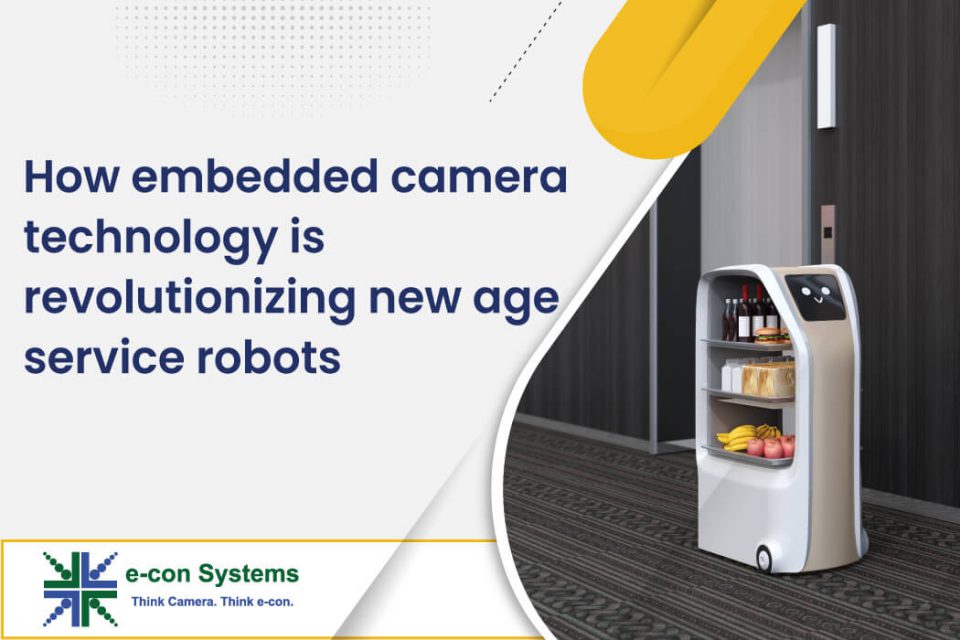Robots are everywhere. From factories to warehouses to hospitals and even our homes, robots today have found applications in almost every area of our lives. As their cognitive abilities improve with developments in artificial intelligence and supporting elements such as camera technology and computer vision, robots have replaced humans not just in mundane tasks, but in activities that require intelligent decision making. And service robots are no exception to this.
In this article, we will do a deep dive into the functions of service robots, and how embedded vision and camera technology play a part in helping them automate various tasks.
What are service robots and where are they used?
According to the International Organization for Standardization, a service robot is defined as “a robot that performs useful tasks for humans or equipment excluding industrial automation applications.” Here, service robots are very broadly defined and cut across multiple industries including agriculture, transportation & logistics, warehouse automation, etc. However, since we have covered how embedded vision helps these robots perform their tasks in other articles based on the categories mentioned in the Autonomous Mobile Robots pillar page, here let us consider service robots used in the following environments:
- Hotels and restaurants
- Office buildings
- Hospitals and clinics
- Retail stores
- Construction sites
- Households (interiors and gardens)
How embedded cameras help service robots collect data and take intelligent decisions
Now that we understand what service robots are and where they are used, let us learn how cameras enable their seamless operation in these environments.
Hotels and restaurants
In hotels and restaurants, service robots are used for mobile guidance, information, telepresence, and material delivery. Mobile guidance involves guiding the guests to the right location within the hotel or restaurant premises. Information refers to acting as a ‘robotic receptionist’ to share necessary information with the guests. Telepresence is about using the robot for telecommunication purposes. And finally, material delivery involves delivering food (or any other item) to the allocated table (in the case of a restaurant) or a particular room (in the case of a hotel) or location.
In this type of service robot, cameras are used for:
- Autonomous navigation by measuring depth using 3D depth cameras.
- Obstacle detection using 2D cameras.
- Object identification and optical character recognition.
Depending on the particular use case, features of the camera to be used such as resolution, frame rate, interface, etc., will differ. To look at the various camera modules offered by e-con Systems by features, please visit the Camera Selector.
Office buildings
In office buildings, service robots are used for the purposes of mobile guidance, material delivery, and social interaction. Like in the case of hotels and restaurants, camera modules are used in this kind of service robot for autonomous navigation, obstacle detection, object identification, and optical character recognition.
In addition to these, robots might also have to collect data on their surroundings. An example would be counting the number of people the robot met and greeted during a particular period. This can be done only with the help of cameras where the images and videos captured by them are analyzed using sophisticated AI algorithms to accurately determine the number of people.
Hospitals and clinics
Medical service robots help reduce the workload for hospital staff and significantly improve the patient experience. They are used for blood extraction, rehabilitation, cleaning & disinfection, and drug delivery. The purpose of cameras is similar in medical robots as well where they help in capturing images and videos of the robot’s surroundings for mapping, localization, navigation/path planning, obstacle detection, object identification, and data collection.
Retail stores
Service robots in retail stores have elevated customer experience by offering more convenience and by gamifying the overall shopping experience. For instance, one of the ways in which service robots are used in retail stores is by delivering items to shoppers once they place the order using a digital kiosk or display. A service robot is also used for guiding shoppers to the desired location in a store.
Embedded cameras in a retail service robot need to have the ability to identify various objects or items in the retail store for ensuring effective delivery. They should also enable the robots to move from one place to the other without running into any obstacles.
Construction sites
Service robots have been pivotal in improving work completion rates and productivity in the construction industry. From laying bricks to inspection to maintenance and demolishing buildings, service robots complement humans in performing a variety of tasks in construction. And cameras help in the following ways:
- Measure the distance to walls or nearby objects.
- Locate the exact position of a brick to be laid.
- View and identify the presence of any unwanted objects or damages in tanks, tubes, pipes, and sewers.
As in the case of other applications, the choice of the camera would depend on the use cases. For instance, to inspect a fast-moving shaft, a global shutter camera is required. Whereas to measure distance, a 3D depth camera needs to be used.
Households
This is where service robots get really ‘cool’. Though service robots are yet to gain widespread popularity among households, the applications they find are very interesting. Some of them include:
- Floor, window, and outdoor cleaning.
- Gardening.
- Serving food.
- Picking and placing objects.
Camera modules play a similar role in household robots as well (as in the case of other service robots). In this case, safety will be of utmost importance and hence the accuracy of images and videos captured takes the top spot when it comes to imaging priorities.
How e-con Systems’ camera solutions can power your next gen service robots
e-con Systems has been an active player in the embedded vision space for more than 18 years now. We take great pride in the wide variety of cameras we have in our portfolio along with our ability to customize them to fit each customer’s requirement. And AMR (Autonomous Mobile Robot) has been one of our key focus segments with extensive experience of working with 50+ AMR manufacturers.
Some of the other key differentiators of e-con Systems when it comes to offering cameras for robots include:
- Highly reliable GMSL2 cameras.
- A portfolio consisting of both rolling shutter and global shutter cameras.
- End to end camera customization services for form factor, optics, firmware, interface, etc.
- 3D depth cameras that can measure depth with an accuracy of more than 99%.
- An extensive portfolio of low light cameras and NIR cameras for use in extremely low light or no light conditions.
To learn more about our camera solutions for robots, visit the AMR markets page. You could also check out the Camera Selector to browse through our complete portfolio of cameras.
As always, if you are looking for help in integrating cameras into your robots, please reach out to us at camerasolutions@e-consystems.com.

Gomathi Sankar is a camera expert with 15+ years of experience in embedded product design, camera solutioning, and product development. In e-con Systems, he has built numerous camera solutions for robots, industrial handhelds, quality inspection systems, smart city applications, industrial safety systems, and more. He has played an integral part in helping hundreds of customers build their dream products by integrating the right vision technology into them.




